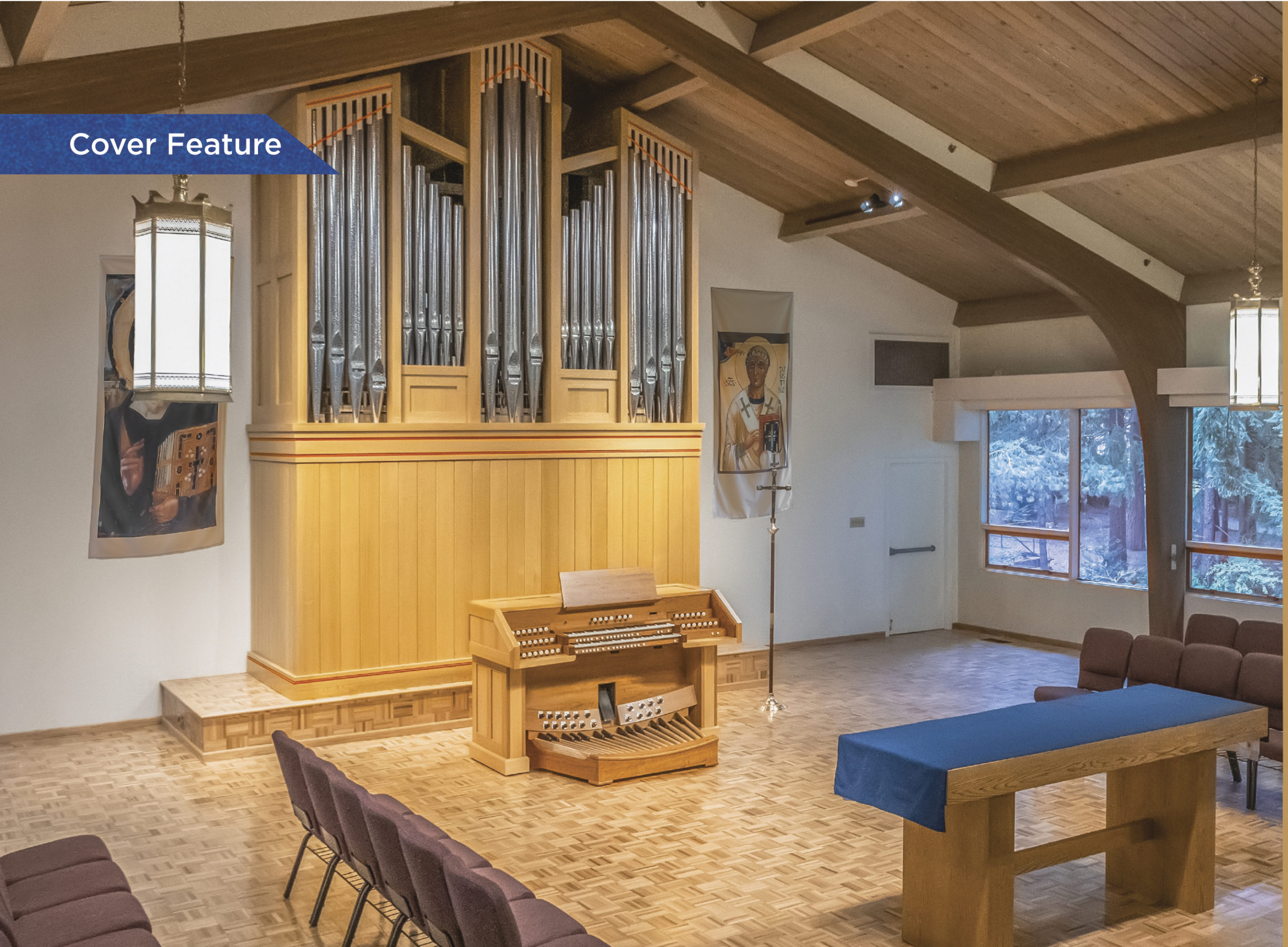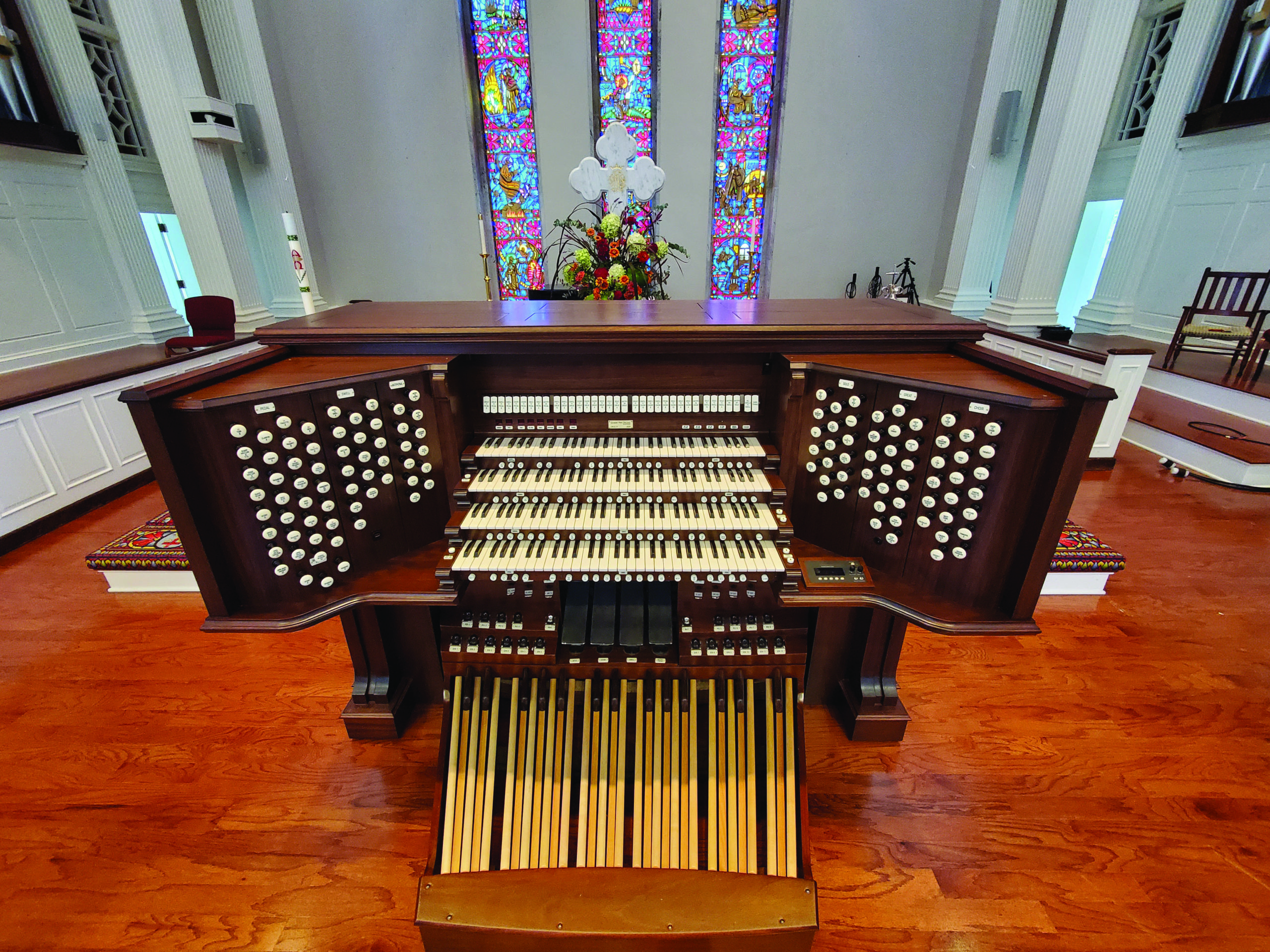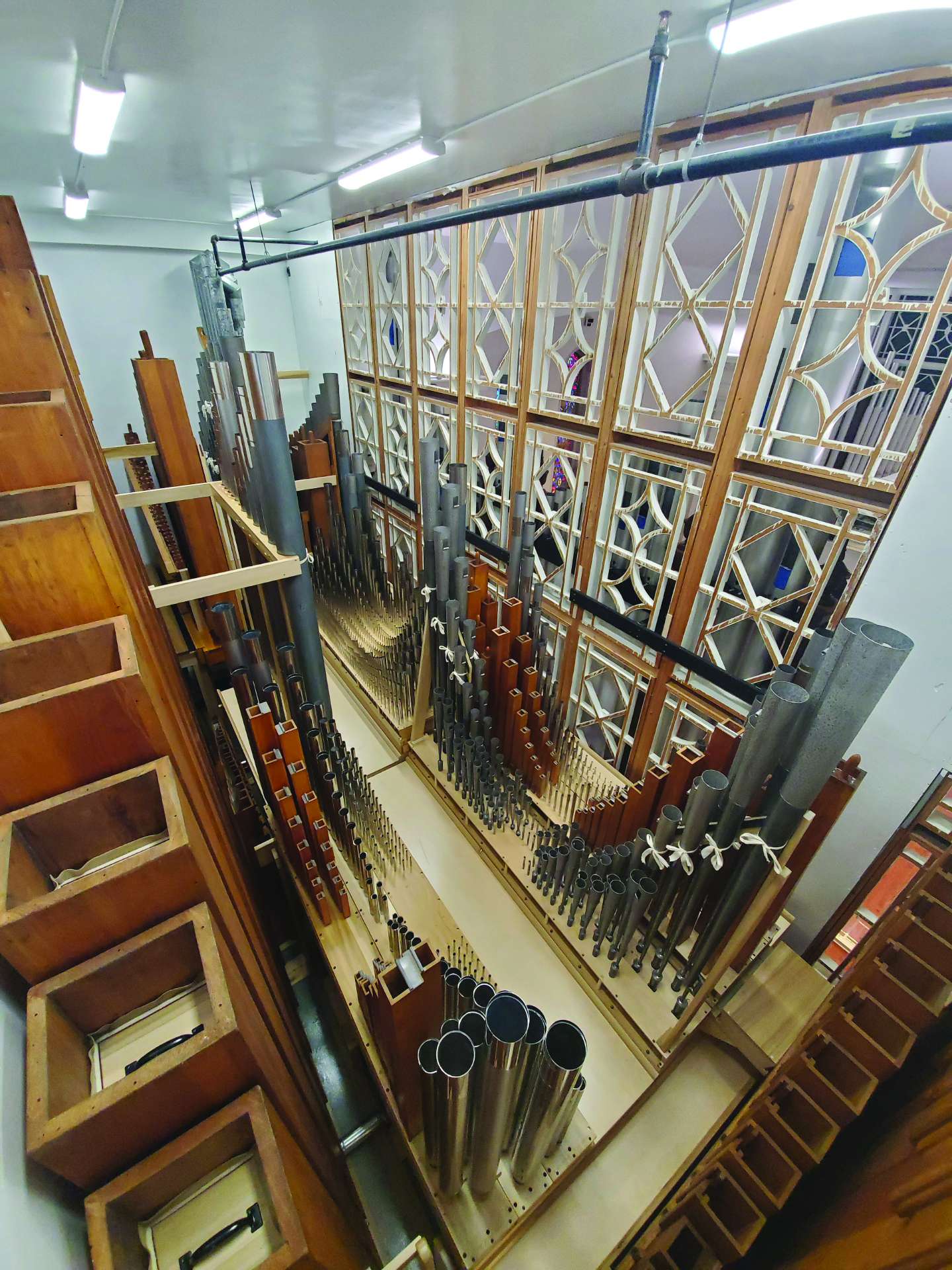The AGO National Council and Staff extend warm wishes for a happy, healthy 90th birthday to AGO Past President Frederick Swann.
The Los Angeles (Calif.) Chapter’s podcast celebrating Fred Swann’s birthday is now available. Click here to listen.
Last Modified on
The AGO National Council and Staff extend warm wishes for a happy, healthy 90th birthday to AGO Past President Frederick Swann.
The Los Angeles (Calif.) Chapter’s podcast celebrating Fred Swann’s birthday is now available. Click here to listen.
Last Modified on

St. Dunstan’s Episcopal Church
Shoreline, Washington
Ortloff Organ Company
Needham, Massachusetts
Stop List
By Jonathan Ortloff

To get a sense of the conviction with which St. Dunstan’s Episcopal Church performs its ministry, visit the church any Tuesday. On those evenings, for the last eleven years, whether rain, snow, or global pandemic, dozens of church members have prepared a huge meal and fed it to more than 250. No wonder that throughout greater Seattle, St. Dunstan’s is known as “the church that feeds people.” The scale of such ministry belies the fact that St. Dunstan’s, like many Episcopal parishes, is a suburban church of modest size. Yet that size has never prevented the parish from entertaining larger visions, either pastoral or musical.
The dedication to outward-facing ministry exemplified in St. Dunstan’s feeding program is matched by a robust commitment to ministry within the congregation. Led by the energetic rector Rev. David Marshall, the congregation is full of hearty, devoted members who throw themselves into the various ministries of the parish with great conviction. This is a church that values music as a ministry, with a spirited program under the direction of Susanna Valleau, encompassing a growing adult volunteer choir and a large lay-led handbell ensemble.
Sixty years ago, St. Dunstan’s had grand plans for a complete campus on a wooded retreat. A familiar reality set in, however, as money wasn’t readily come by, and in the end the congregation raised enough to build a parish hall; the church proper would remain a blueprinted intention. In turn, the hall became a de facto worship space, with a secondhand Hutchings-Votey installed by “the men of the church.” Nevertheless, the people of St. Dunstan’s never stopped dreaming of a new organ, starting a fund for one 22 years ago.
Our company’s relationship with St. Dunstan’s began in the winter of 2018, when I was asked to consult about the logistics of installing a particular vintage organ there. As I would learn, the organ committee was a tight-knit, devoted, and fun group; having done thorough homework, they asked smart questions. Their commitment to making the best decision was born out of a shared dedication to ministry and character. They wanted an instrument as unpretentious as the congregation and the space, one well suited to the distinct worship there. But they wanted something more than mere variety from a limited number of stops: they wanted an organ of character. Moreover, they had already deduced that greater Seattle was rich in mechanical-action organs, of many sizes and tuning systems. A small electric-action instrument in equal temperament, with something of a Romantic bent, was for St. Dunstan’s a way to provide variety and be part of a larger mission of musical stewardship in the community.

When it became clear that the complex space effectively demanded a custom-designed new organ, the committee decided to commission one. Because of the relationship established during that initial phase of inquiry, they went to see our Opus 1 in Penfield, New York. In turn, and quite flatteringly, they decided to commission our Opus 2.
On the mundane face of it, organ projects are about designing cases and mechanisms; building pipes, structure, chests, and action; and voicing and tonal finishing. What happens in the workshop, however, is almost always a reflection of something deeper: the relationships formed in shaping and completing the project itself. And in this instance, those bonds were early and strong, making the experience all the more fulfilling. With shared interests in boatbuilding, woodworking, rowing, and our common faith, Rev. Marshall and I were fast chums. Out of that relationship came trust, no small matter for just the second instrument from an organ shop, one being built on the other side of the continent and 16 months in the future. When it became clear that our shop’s COVID shutdown at the pandemic’s height would delay the organ’s completion, Rev. Marshall said frankly, “Having an organ for Pentecost [the original goal] seems so unimportant now. You take care of your people; we’ll take care of ours, and we’ll all be elated whenever this instrument sounds in our church for the first time.” Chris Johns, St. Dunstan’s clerk of the works and a retired Boeing engineer, guided the project from the church’s end and dedicated himself to designing and completing the infrastructure to support the new organ “the right way.” Ever cheerful, he always made himself available to check measurements or to consult on technical matters, returning data on beautiful, hand-wrought scale drawings.
Perhaps most important in the building of a musical instrument is a strong relationship such as the one that grew with St. Dunstan’s organist and music director Susanna Valleau. A graduate of Lawrence University and the University of Washington, she has served the parish for six years. Susanna and I met while working at the 2011 AGO Pipe Organ Encounter in Boston, and we renewed our connection on this project. Her enthusiasm throughout the job injected energy into both the parish and us as builders. She visited twice during construction, and her excitement in seeing and hearing parts of the new instrument encouraged us in our work. Most importantly, she and I had broad agreement over a vision for the organ: one that put accompaniment of the Episcopal liturgy right out front.

Our proposal stated the organ’s chief goal as providing “not just support for congregational and choral singing, but an ensemble that energizes and compels worshippers to sing, and serves as a partner in that singing.” In a room that seats 200, we were sensitive to providing an ensemble that would energize without being overbearing. To this end, the overall tonal goal was to voice chorus work with both warmth and a scintillating yet restrained energy, something that gives the impression of grandeur without being plainly loud. In my view, this kind of voicing, aided by high-lead alloy for much of the pipework, truly does compel singing.
My experience as an Episcopal church organist informed much of how the organ’s stops are arranged, scaled, and voiced. Chief among those choices was placing both reeds and the organ’s sole mixture in the Swell. Two factors are at play here. In this intimate, nonreverberant space, intense upperwork to complete the Great chorus was desirable, but it ultimately benefited from the moderation provided by enclosure. Just as important, intense mixture tone, merged with reeds, all closed down behind shutters, is one of the most thrilling and necessary sounds for accompanying. In this instance, the mixture clearly belonged in the Swell. Thick shutters ensure proper caging of the lion.
Nestled among the basics are certain effects that suggest big-organ grandeur: bold strings, a soloistic Harmonic Flute, a rich, warm 16-foot chorus. At the same time, delicate, intimate voices that might otherwise get lost in a larger room were included here to good effect, such as the Swell’s quirky Spindle Flute. The resourceful organist will find many opportunities for color here, particularly using stops up and down octaves.
Beyond the new relationships a job fosters, existing relationships with longtime colleagues bring the talents and skills to complement those of our shop. As in past jobs, I turned to my mentor Steve Russell for the construction of many pipes. Our relationship goes back to my very first day as an organbuilder, spawning nine years working in his shop. Having that deep common experience means that we speak exactly the same language when it comes to pipe construction. The strings, facade, and reeds were made by Shires Organ Pipes of Leeds, England—a new relationship for us. Terry Shires asked all the right questions of a new customer and was attentive to our requests in the smallest detail. Reed voicer Chris Broome and I burned up the ether texting back and forth about every little thing having to do with a mere two reed stops. His concern for their success, from the initial samples through to tonal finishing, mirrored my own. Christoph Wahl provided vital assistance in the construction of slider chest grids, and finally, Organ Supply Industries expertly made wood pipes to our specifications.

The completion and installation of this instrument was, like everything else in 2020, beset by the COVID-19 pandemic. Our shop shutdown for three months meant that meeting the original installation schedule was impossible; moreover, our concern for safe travel put a question mark over the end of the job. Would we fly? Would we stay in a hotel? Where would we eat? How long could we keep this completed instrument in our shop waiting for the pandemic to recede? With seemingly no end in sight, we convinced ourselves of the safety of flying, elected to stay in an Airbnb, and set a late August date for installation. As in past jobs, we turned to our long-standing relationship with the Organ Clearing House crew—Amory Atkins, Terence Atkin, Josh Wood—to ensure a successful installation. Once on site, I was not a little proud to see an instrument that had taken 16 months to build get erected and fully piped in merely four days. Finally, Duane Prill joined me for two weeks of tonal finishing.
The joy of this organ’s completion was twofold for our company: not only in building the instrument, but in seeing the impact it has had on the people we developed close relationships with over the past three years. These warm relationships feed us as we journey through a project with a church, and we are blessed to have truly made new friends at St. Dunstan’s. For these good people, Ortloff Organ Company is honored to offer this, our second opus, to this hearty parish. It is my hope that it will feed the church that feeds people for generations to come.
Ortloff Organ Company
Bart Dahlstrom
Corey DeTar
Jonathan Ortloff
Patrick Walsh
Jonathan Ortloff is the founder and president of Ortloff Organ Company, LLC. He holds degrees from the Eastman School of Music and the University of Rochester in organ performance and engineering.
Last Modified on
 June 27–July 2 at 8PM Eastern
June 27–July 2 at 8PM EasternClick here and join us for an exciting lineup of performances featuring individuals from all seven AGO regions:
RECITALS
■ Christine Clewell
■ Monica Czausz
■ Nathaniel Gumbs
■ Ahreum Han
■ Jaebon Hwang
■ Christopher Jacobson
■ Nicole Keller
■ Peter Krasinski
■ Kevin Kwan
■ Aaron David Miller
■ Raúl Prieto Ramírez
■ Kris Rizzotto
Plus, this year’s virtual festival takes audience engagement and interaction to a new level with these offerings:
WORKSHOPS
■ Organ Improvisation: Developing Skills and Techniques
■ OrganPlus: Chamber Music
ROUNDTABLE DISCUSSIONS
■ American Organbuilding: Present Trends and Future Predictions, moderated by Jonathan Ortloff
■ Diversity and Equity: Widening our Repertoire in Sacred Music, Teaching, and Performing, moderated by Janet Yieh
PIPETALKS
■ The 100th Anniversary Death Year of Camille Saint-Saëns
■ The Organ Music of Florence Price
■ Leo Sowerby at St. James Cathedral, Chicago
■ Celebrating Marcel Dupré (50 Years after Death) and Jeanne Demessieux (100 Years after Birth)
■ Meet the Editor: Oxford Hymn Settings Collection
■ Meet the Editor: MorningStar African American Organ Music Anthology
■ Liturgical Choral and Organ Music by Women: A Great Host of Composers and Amplify Female Composers
■ A Pastoral Conversation on the Return to Singing
■ Exploring the Hammond Organ
■ Injury Prevention for Lifelong Music-Making
Attendees will have the opportunity to view the final round of the National Competition in Organ Improvisation and vote for an audience prize, mingle at Zoom after-parties, and more.
Last Modified on

First United Methodist Church
Athens, Georgia
Quimby Pipe Organs Inc.
Warrensburg, Missouri
By Chris Emerson and Daniel Sliger
Stop List

First United Methodist Church of Athens, Georgia, is home to the newest instrument by Quimby Pipe Organs Inc. of Warrensburg, Missouri. The four-manual, 68-rank Opus 77 was created through the collaboration of Michael Quimby, owner and tonal director; T. Daniel Hancock, former company president; James F. Mellichamp, president and professor of music, Piedmont College, Athens, Georgia, consultant; Stephen Mitchell, director of music; and Janis Maxwell, organist. The organ is designed primarily to lead worship and then to serve a variety of musical and liturgical functions. It is not intended to copy any particular school or period of organbuilding, but to embrace the needs of the church and to provide an instrument that not only serves for recitals but can also be used in the wide variety of musical genres found in the worship practices of the 21st century.

Tonally, the instrument is unique in a number of ways. First, it has four enclosed divisions. Second, the 32′ and 16′ Pedal reed stops and all other manual 16′ reeds are full length. Third, the instrument contains certain features of the symphonic style of organ that was sought after in the late 19th and early 20th centuries. Michael Quimby and his team have played a leading role in reviving and developing this style of building over the last two decades. Fourth, departing from the symphonic tradition, each division of the instrument, excluding the Solo, contains a completely developed diapason chorus. This has proven to increase the versatility of the instrument in Classical, Romantic, and symphonic styles of music. One thing that sets these diapason chorus ranks apart is the unusual use of substantially thick metal, using antimony and trace elements for stability. Over the last 25 years we have discovered that using thicker metal allows the pipework to be voiced to its full potential, providing stability in pipe speech and achieving the optimum in harmonic development. Another feature is the chorus of trumpets and orchestral reeds, including the Tuba, French Horn, Oboe, English Horn, and Corno di Bassetto, all voiced by our head reed voicer, Eric Johnson. Of particular interest are two contrasting solo reeds, the Tuba in the Solo division and the Hooded Trumpet in the Antiphonal division, voiced on 20” and 10” wind pressure respectively.

Mechanically, our instruments feature the use of our version of the Blackinton slider windchest, distinguished by a pneumatic pallet design and absence of slider seals, allowing for the flue pipes in each division to speak without the explosive attack experienced by individual valves, since each note shares a common note channel with the other ranks. The reed ranks, Solo, Pedal, and offset pipes are on electropneumatic pouch-style windchests.

As with most instruments, the console is seen as the crown jewel of the installation. Made of solid mahogany, in the Aeolian-Skinner style, with walnut drawknob jambs, coupler rails, and accents, the console incorporates the Virtuoso control system, provided by Integrated Organ Technologies of Alpharetta, Georgia. The solid mahogany case, designed by T. Daniel Hancock and built by Southern Elegance Custom Cabinetry of Crawford, Georgia, incorporates design features from both the existing grille work and the sanctuary, achieving an aesthetically elegant display. Located in the chancel facade are notes 1–21 of the Great 16′ Double Open Diapason and notes 1–12 of the Pedal 8′ Octave.

We wish to thank all of those at First Methodist who made our stay in Athens an enjoyable one: Chuck Hodges, senior pastor; Dave Walton, business administrator; Bob Winstead, executive director of administration and project manager; Steven Mitchell and Janice Maxwell of the music staff; and all those in the congregation who showed us the love of Christ by supplying us with treats and meals throughout the installation.
Quimby Pipe Organs Inc.
Melody Burns
Jacob Christopher
Chris Emerson
Chuck Ford
Samantha Koch Hancock
T. Daniel Hancock
Eric Johnson
Kevin Kissinger
Joseph Nielsen
Michael Quimby
Janille Rehkop
Jim Schmidt
Brian Seever
Dan Sliger
Anthony Soun
Mahoney Soun
Chirt Touch
Bailey Tucker
Chris Emerson (project lead) is a pipe maker, tuner/technician, and head of the service department at Quimby Pipe Organs. He has been with the company for more than 30 years, having served in nearly every area since 1990.
Dan Sliger (project lead) was shop manager for the American Organ Institute at the University of Oklahoma from 2011 to 2016. He came to the organbuilding industry during his last year of college as a student employee of the AOI with a longtime interest in woodworking. His experiences include reservoir and chest construction as well as drafting and design. Dan is a member of the American Institute of Organ Builders and has been with the Quimby firm since 2016.
Last Modified on
We extend our deepest, heartfelt sympathy and prayers to Lynn Dobson, John Panning, and to all our good friends at Dobson Pipe Organ Builders of Lake City, Iowa. Their offices and workshop were destroyed in a fire on Tuesday, June 16. “The shop is a total loss,” Lynn Dobson declared. He hopes to rebuild. Dobson is currently installing a new organ at St. Christopher’s Episcopal Church in Chatham, Mass., where AGOHQ staff member Maury Castro is the music director.
Last Modified on
The AGO wants every member to know how much we care about them. Throughout the month of June, all members will be receiving a call from AGO staff and volunteer leadership to say thank you for being such a great member.
Put double quotation marks around multi-word searches. Hit Enter to process.
Achievement Awards
AGOYO
Antitrust Compliance
Ask the Organbuilder
Change of Address
Chapter Deans Contact
Chapter Documents
Chapter Liability Insurance
Chapter Toolkits
Classified Ads
Contact Us
Find a Job
Find an Organ Teacher
Guild Documents
Insurance for AGO members
Pipe Organ Encounters
Post a Job
Privacy Policy
Salary Guidelines
Strategic Growth Plan
